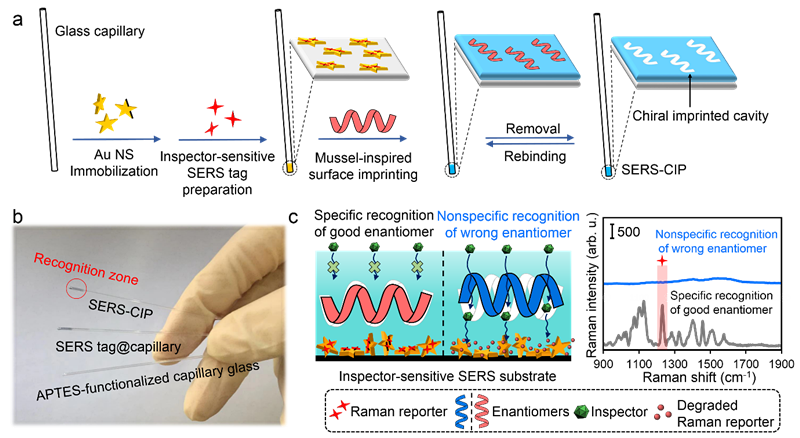Progress in chiral imprinting SERS strategy for absolute enantiomer discrimination in Yantai coastal zone
Chen Lingxin's team from Yantai Coastal Zone Research Institute, Chinese Academy of Sciences has made important progress in the field of chiral imprinted surface enhanced Raman scattering (SERS) detection technology. The research achievement entitled "Chiral molecular imprinting based SERS detection strategy for absolute enantiomeric discrimination" was published in the latest issue of Nature Communications.
Chirality is a ubiquitous phenomenon in nature. The enantiomers of a chiral molecule are non-superimposable mirror images of each other. The enantiomers of a chiral molecule despite the similar physical and chemical properties, exhibit distinct pharmacological, biological, and toxicological activities. Therefore, chiral discrimination is an indispensable tool that has pivotal importance in accurately recognizing enantiomers. However, there are many challenges in the recognition of a single enantiomer. Absolute enantiospecificity, high recognition sensitivity, and versatility are three prerequisites of an ideal chiral discrimination strategy, which have been rarely achieved simultaneously. Firstly, how to inhibit the non-specific binding of enantiomers on the chiral discrimination sensor is the key. Enantiomers of a chiral molecule have an identical molecular size and functional groups and they cannot be fully discriminated according to host–guest interaction on the chiral selectors. In addition, most chiral discrimination strategies are highly dependent on the molecular characteristics of chiral molecules and cannot be applied to a wide variety of chiral compounds.
Coastal zone is the key zone of the earth which is related to the development of human society. The development of marine carbon fixation and protection of ecological environment is one of the keys to sustainable development of coastal zone. Amino acids are important components of marine organic carbon and organic nitrogen. Chiral conversion of amino acids is an important process of marine microbial carbon fixation. However, the concentration of chiral amino acids in the coastal zone environment is very low and the medium is complex, so it is necessary to develop a highly sensitive chiral detection technology.
Based on the above challenges, Chen Lingxin's team innovatively developed an inspector recognition mechanism (IRM) implemented on the surface enhanced Raman scattering based chiral imprinted platform (SERS-CIP) as shown in Figure 1. The IRM benefits from the advantages of absolute enantiospecificity, high sensitivity analysis, and versatility, enabling absolute discrimination and recognition of a wide variety of chiral molecules as exemplified by six chiral amino acids and three carbohydrates. Besides, the practical application of the SERS-CIP was demonstrated by the recognition of chiral compounds in seawater and urine samples. Chiral imprinted platform (CIP) has cavities that complement the good enantiomer in shape, size and functional group. It can bind the enantiomer with high specificity, showing a unique advantage in chiral recognition. Due to the interaction between the polymer framework and the functional groups of chiral molecules, the problem of nonspecific binding in chiral recognition is always a challenge. It has been found that the enantiospecificity of CIP can be improved by developing an advanced recognition mechanism and curbing non-specific binding. By using various instrumental techniques a detailed study on the non-specific binding sources of CIP was conducted. Importantly, the team developed a detection and recognition mechanism to explore the spatial status of chiral imprinted cavities of CIP after chiral recogition, to distinguish specific binding and non-specific binding. The enantioselectivity test, racemic mixture analysis and chiral recognition in complex real samples show that this mechanism can meet the requirements of ideal chiral recognition strategies and has good practicability.

Figure 1. The SERS-CIP construction and Principle of IRM. a Schematic illustration of the SERS-CIP construction. b Photo images of APTES-functionalized capillary glass, SERS tag@capillary, and SERS-CIP. The recognition zone is illustrated by a red circle. c Principle of IRM implements on SERS-CIP.
This research achievement has been supported by the National Natural Science Foundation of China and the International Postdoctoral Program of the Chinese Academy of Sciences. The first author of the article is Maryam Arabi Assistant Researcher, and the corresponding authors of the article are Wang Yunqing and Chen Lingxin.
Article link:https://www.nature.com/articles/s41467-022-33448-w